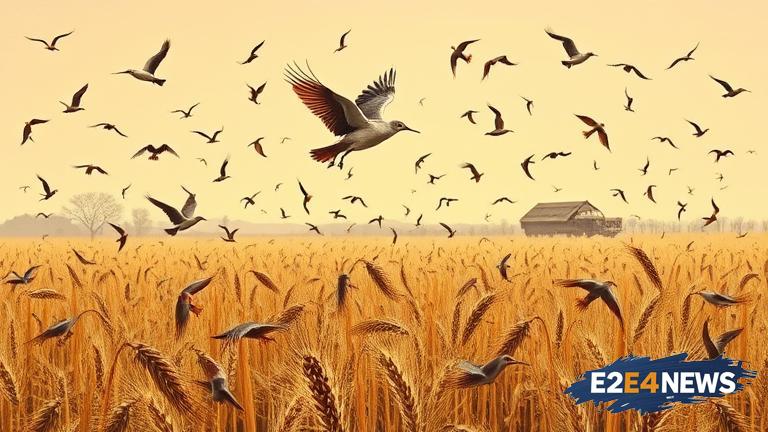In a bid to protect its winter wheat crop, Zimbabwe has embarked on a large-scale culling of quelea birds, with a staggering 120,000 birds eliminated so far. The quelea bird, known for its voracious appetite, poses a significant threat to the country’s agricultural sector, particularly its wheat crop. The culling operation is part of a broader effort to mitigate the economic impact of the birds on the country’s food security. Zimbabwe’s agricultural sector is a critical component of its economy, and the government is taking proactive measures to ensure the sector’s stability. The quelea bird, which is native to sub-Saharan Africa, is known to cause significant damage to crops, including wheat, maize, and sorghum. The birds’ feeding habits can result in substantial losses for farmers, making it essential to control their population. The culling operation is being carried out by the Zimbabwean government in collaboration with local farmers and agricultural experts. The use of poison baits and other control measures has been effective in reducing the quelea bird population. However, the operation is not without its challenges, as the birds are highly mobile and can be difficult to track. Despite these challenges, the government remains committed to protecting the country’s agricultural sector. The culling of quelea birds is a temporary solution to a long-standing problem, and the government is exploring more sustainable and environmentally friendly methods to control the bird population. One such method is the use of bird-scaring devices, which can be an effective deterrent without causing harm to the birds. Additionally, the government is working with local communities to develop quelea bird management strategies that take into account the birds’ ecological role. The quelea bird is an important part of the ecosystem, and its population needs to be managed in a way that balances the needs of farmers with the need to conserve the species. The government’s efforts to control the quelea bird population have been welcomed by farmers, who have seen significant losses due to the birds’ feeding habits. The culling operation is a critical component of the government’s broader strategy to boost agricultural production and ensure food security. Zimbabwe’s agricultural sector has faced numerous challenges in recent years, including drought, pests, and diseases. However, the government remains committed to supporting the sector and ensuring its stability. The culling of quelea birds is a significant step towards achieving this goal, and the government is exploring other measures to support farmers and boost agricultural production. These measures include the provision of subsidies, training, and other forms of support to help farmers improve their productivity and competitiveness. The government is also investing in agricultural research and development, with a focus on improving crop yields and developing more resilient crop varieties. Furthermore, the government is working to improve the country’s agricultural infrastructure, including irrigation systems and storage facilities. These efforts are critical to ensuring the long-term stability of the agricultural sector and the country’s food security. In conclusion, the culling of quelea birds is a necessary measure to protect Zimbabwe’s winter wheat crop and ensure the country’s food security. The government’s efforts to control the quelea bird population are part of a broader strategy to support the agricultural sector and boost production. While there are challenges to be addressed, the government remains committed to finding sustainable and environmentally friendly solutions to the problem.
